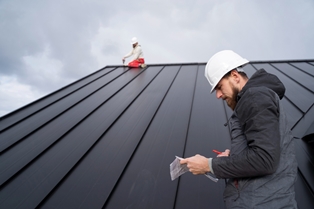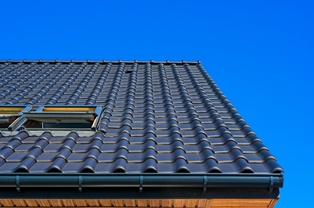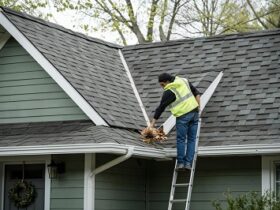When it comes to extreme weather, your roof is the first line of defense against the elements. Homes in areas with frequent hurricanes, heavy snowfall, or intense sun exposure face unique challenges that demand proactive measures to protect roofing structures. Knowing the leading practices for roof maintenance and storm-proofing can extend your roof’s lifespan, reduce repair costs, and keep your home safe. Here’s how Last Call Exteriors can help you protect your roof through careful planning, maintenance, and material selection.
Hurricane-Prone Areas
Hurricanes bring strong winds, torrential rains, and debris, all of which can wreak havoc on a roof. In regions prone to hurricanes, strengthening your GRB roofing system and prioritizing wind-resistance measures is essential.
Best Roofing Materials for High-Wind Resistance
- Metal Roofing: Metal roofs, especially those designed for wind resistance, are ideal in hurricane-prone areas. They offer durability and resistance against high winds, with the added advantage of lower maintenance.
- Clay or Concrete Tiles: These are heavy and have excellent wind-resistance ratings. However, they must be secured properly with appropriate adhesives or nails to withstand powerful gusts.
- Asphalt Shingles: High-wind-rated shingles (labeled “Class F” or “Class H”) offer excellent performance for winds up to 130 mph, especially when installed by certified professionals.
Roof Reinforcement Tips
- Hurricane Straps and Clips: Installing hurricane straps or clips helps secure the roof to the house’s structure, making it harder for the wind to lift the roof away.
- Nailing Patterns: Roof nails play a crucial role in wind resistance. Using a more frequent nailing pattern and securing shingles tightly to the underlayment can provide extra strength.
- Sealing Vulnerable Points: Water intrusion often begins at seams, flashings, and around roof penetrations like chimneys and vents. Reinforcing these points with extra waterproofing materials can prevent rain-driven leaks.
Regular inspections before hurricane season are also critical. An inspector can catch loose shingles, damaged flashing, or other weaknesses that could lead to further damage during high winds.
Heavy Snow and Ice Conditions
Snow accumulation and ice dams present significant risks for homes in snowy climates. The weight of snow can cause roof collapse, while ice dams can create water seepage and structural damage.
Best Roofing Materials for Cold Weather
- Metal Roofs with Ice and Water Shields: Metal roofing sheds snow and prevents ice buildup. Adding ice and water shields beneath the metal roofing can also help protect against leaks.
- Slate Roofing: Slate is exceptionally durable and resistant to extreme cold and moisture. Proper installation ensures these tiles stay in place during snow-heavy winters.
Snow Management Tips
- Install Snow Guards and Snow Fencing: Snow guards are barriers that prevent large sheets of snow and ice from sliding off the roof all at once, which can cause structural damage and pose a risk to people below.
- Add Roof Insulation: Insulating your attic keeps warm air inside the house, which helps reduce snow melting on the roof and refreezing at the edges, preventing ice dams.
- Proper Roof Ventilation: Good airflow in the attic prevents warm air from heating up the roof too much, which can cause snow to melt unevenly. This simple fix can significantly reduce the formation of ice dams.
If snow accumulation becomes excessive, consider hiring professionals to clean your roof. Attempting this yourself could be dangerous without the proper equipment.
Intense Sun and Heat
In areas with high sun exposure, roofs are at risk of heat damage, UV deterioration, and thermal shock. Consistent exposure to extreme sunlight can cause roofing materials to fade, crack, and lose effectiveness.
Best Roofing Materials for Sun Resistance
- Tile Roofing: Clay and concrete tiles are exceptionally resilient under sun exposure, maintaining their integrity and color better than many other materials.
- Metal Roofing with Reflective Coating: Metal roofs with reflective coatings can repel much of the sun’s heat, keeping the structure cool and preventing damage. This roofing option is energy-efficient and long-lasting.
- Cool Roofs: A cool roof has a high solar reflectance and thermal emittance rating, which means it absorbs less heat and reflects more sunlight. Options include specially treated asphalt shingles, light-colored tiles, and certain single-ply membranes.
UV Protection and Maintenance Tips
- Reflective Coatings and Sealants: Applying a UV-resistant coating to your roof extends its life by reducing the impact of the sun’s rays.
- Regular Inspections for Cracks and Fading: Sun damage causes materials to degrade, often starting with small cracks or fading. Taking care of these issues can prevent costly repairs in the long run.
- Install Roof Vents or Attic Fans: Good ventilation helps prevent heat buildup under the roof, which can reduce interior temperatures and extend your roof’s lifespan.
In high-heat environments, a well-maintained roof can also improve your home’s energy efficiency, reducing cooling costs in the summer.
General Maintenance for Extreme Weather Protection
Regardless of climate, certain general maintenance practices can help protect your roof from extreme weather:
- Routine Inspections and Prompt Repairs: Inspect your roof twice a year and after any major weather event. Look for missing or loose shingles or water stains on the ceiling. Address issues promptly to prevent further deterioration.
- Gutter Cleaning and Maintenance: Clogged gutters can cause water to pool, leading to water damage and rot. Clean your gutters regularly to ensure they direct water away from your roof and home foundation.
- Trim Overhanging Trees: In all climates, overhanging branches pose a threat to your roof. During high winds, branches can scrape or puncture the roof, while falling branches can cause significant damage. Trim back trees to a safe distance to prevent these risks.
Planning for the Future
Extreme weather is unpredictable, but by preparing your roof for the specific challenges posed by your climate, you can significantly increase its resilience. When considering a new roof or significant repairs, consult a professional who understands the needs of your region.
By proactively selecting materials, reinforcing key areas, and performing regular maintenance, you can protect your roof and ensure it remains an effective shield for your home. Investing in your roof’s durability not only preserves your home’s value but also keeps you and your family safe, no matter what the weather brings.










Find Us on Socials